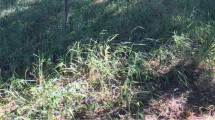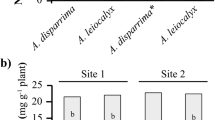Summary
Alnus species are used widely in Britain for land reclamation, forestry and other purposes. Rapid juvenile growth of the AmericanAlnus rubra makes it an attractive species for planting on N-deficient soils, particularly those of low organic content. In small plot trials, this species is nodulated by indigenous soil frankiae as effectively asAlnus glutinosa. Over a three year period both species return similar amounts of N to the ecosystem, estimated at up to 10–12 kg N ha−1. Several strains ofFrankia have been isolated from local (Lennox Forest)A. rubra nodules. These differ morphologically and in their growth on different culture media, both from each other and fromA. glutinosa nodule isolates. AllAlnus isolates, however, have a total cellular fatty acid composition qualitatively similar to some other Group B frankiae. Glasshouse tests in N free culture suggest thatA. rubra nodules formed after inoculation of seedlings with American spore (−) isolates are three times more effective in N fixation than those inoculated with LennoxA. rubra spore (+) nodule homogenates. By contrast, the early growth of seedlings inoculated with spore (−)Frankia strains suggests at best a 35% improvement in N fixing activity over seedlings inoculated with LennoxA. rubra nodule isolates. Nevertheless, this improvement in activity, together with the better performance of seedlings inoculated with isolates compared with those treated with crushed nodule preparations, suggest that it would be worthwhile commercially to inoculate nursery stock with a spore (−)Frankia strain.
Similar content being viewed by others
References
Akkermans A D L, Baker D, Huss-Dannel K and Tjepkema J D (Eds.) 1984Frankia Symbioses. Martinus Nijhoff/W. Junk, The Hague. 258 p.
Akkermans A D L 1971 Nitrogen fixation and nodulation ofAlnus andHippophae under Natural Conditions. Ph.D. Thesis, University of Leiden p 39.
Benson D R 1982 Isolation ofFrankia strains from alder actinorhizal nodules. Appl. Env. Microbiol. 44, 461–465.
Benson D R, Bucholz S E and Hanna D G 1984 Identification ofFrankia strains by twodimensional polyacrylamide gel electrophoresis. Appl. Env. Microbiol. 47, 489–494.
Bond G 1983 Taxonomy and distribution of non-legume nitrogen-fixing systems.In Biological Nitrogen Fixation in Forest Ecosystems. Martinus Nijhoff/W. Junk, The Hague. pp 55–88.
Borman B T and Gordon J C 1983 Quoted in reference 20.
Bostid 1980 Firewood Crops: Shrub and Tree Species for Energy Production. National Academy Press, Washington, D.C. 237 p.
Briggs D G, DeBell D S and Atkinson W A (Eds) 1978 Utilisation and Management of Alder. USDA Forest Service Tech-Rep. PNW-70, Pacific NW For. Range Exp. Sta. USDA, Portland, Oregon, 379 p.
Burggraaf A J P and Shipton W A 1982 Estimates ofFrankia growth under various pH and temperature regimes. Plant and Soil 69 157–168.
Cote B and Camire C 1984 Growth, nitrogen accumulation and symbiotic dinitrogen fixation in pure and mixed plantings of hybrid poplar and black alder. Plant and Soil 78, 209–220.
Dawson J O 1983 Dinitrogen fixation in forest ecosystems. Can. J. Microbiol. 29, 979–992.
Dawson J O and Sun S-H 1981 The effect ofFrankia isolates fromComptonia peregrina andAlnus crispa on the growth ofAlnus glutinosa, A. cordata andA. incana clones. Can. J. For. Res. 11, 758–762.
DeBell D S and Radwan M A 1979 Growth and nitrogen relations of coppiced black cottonwood and red alder in pure and mixed plantings. Bot. Gaz. 140 (Suppl.), 97–101.
Dillon J T and Baker D 1982 Variations in nitrogenase activity among pure-culturedFrankia strains tested on actinorhizal plants as an indication of symbiotic compability, New Phytol. 92, 215–220.
Gordon J C and Wheeler C T 1978 Whole plant studies on photosynthesis and acetylene reduction inAlnus glutinosa. New Phytol. 80, 179–186.
Gordon J C and Wheeler C T (Eds) 1983 Biological Nitrogen Fixation in Forest Ecosystems. Martinus Nijhoff/W. Junk, The Hague. 342 p.
Gordon J C, Wheeler C T and Perry D A (Eds) 1979 Symbiotic nitrogen fixation in the management of temperate forests. Forest Research Lab., Oregon State University, Corvallis. 501 p.
Hall R B and Maynard C A 1979 Consideration in the genetic improvement of alder.In Symbiotic Nitrogen Fixation in the Management of Temperate Forests. Forest Research Laboratory, Oregon State University, Corvallis. pp 322–344.
Hansen E A and Dawson J O 1981 Effect ofAlnus glutinosa on hybridPopulus height growth in a short-rotation intensively cultured plantation. Forest Sci. 49–59.
Heilman P and Ekuan G 1982 Nodulation and nitrogen fixation by red alder and Sitka alder on coal mine spoils. Can. J. Forest. Res. 12, 992–997.
Heilman P and Stettler R F 1983 Phytomass production in young mixed plantations ofAlnus rubra (Bong). and cottonwood in Western Washington. Can. J. Microbiol. 29, 1007–1013.
Houwers A and Akkermans A D L 1981 Influence of inoculation on yield ofAlnus glutinosa in The Netherlands. Plant and Soil 61, 189–202.
Huss-Danell K 1980 Nitrogen fixation and biomass production in clones ofAlnus incana. New Phytol. 85, 503–511.
Lalonde M and Calvert H E 1979 Production ofFrankia hyphae and spores as infective inoculant forAlnus species.In Symbiotic Nitrogen Fixation in the Management of Temperate Forests. Forest Research Lab., Oregon State University Corvallis, pp 95–110.
Lechevalier M P 1984 The taxonomy of the genusFrankia. Plant and Soil 78, 1–6.
Lechevalier M P, Baker D and Horriere F 1983 Physiology, chemistry, serology and infectivity of twoFrankia isolates fromAlnus incana ssp.rugosa. Can. J. Bot. 61, 2826–2833.
Malcolm D C, Hooker J E and Wheeler C T 1985 TheFrankia symbiosis as a source of N in forestry: a case study of symbiotic nitrogen fixation in a mixedAlnus-Picea plantation in Scotland. Proc. Roy. Soc. Edin. B. 85B, 263–282.
Miller H G 1983 Nutrient cycling in alder. IEA Report NE 1983: 2 National Swedish Board for Energy Source Development, Stockholm pp 54.
Minnikin D E and Goodfellow M 1981 Lipids in the classification ofBacillus and related taxa.In The aerobic Endospore-forming Bacteria Classification and Identification. Eds. R C W Berkeley and M Goodfellow, Academic Press, London pp 59–90.
Normand P and Lalonde M 1982 Evaluation ofFrankia strains isolated from provenances of twoAlnus species. Can. J. Microbiol. 28, 1133–1142.
Perinet P and Lalonde M 1983In vitro propagation and nodulation of the actinorhizal host plantAlnus glutinosa (L.) Gaertn. Pl. Sci. Lett. 29, 9–17.
Pommer E 1959 Über die Isolierung des Endophyten aus den WurzelknöllchenAlnus glutinosa Gaertn. und über erfolgreiche Reinfektionsversuche. Ber. Deutsch. Bot. Gesell. 72, 138–150.
Shipton W A and Burggraaf A J P 1982 A comparison of the requirements for various carbon and nitrogen sources and vitamins in someFrankia isolates Plant and Soil 69, 149–161.
Silvester W B 1974 Ecological and economic significance of the non-legume symbiosis.In Proceedings First International Symposium on Nitrogen Fixation. Eds. W E Newton and C J Nyman. Washington State University Press, Pullman, pp 489–506.
Supelco, Inc. Identification of Bacteria by Analysis of Cellular Fatty Acids. Bulletin 767A.
Teissier du Cros E, Jung G and Bariteau M 1984 Alder-Frankia interactions and alderpoplar assocation for biomass production. Plant and Soil 78, 235–243.
Torrey J G and Tjepkema J D (Eds.) 1979 Symbiotic Nitrogen Fixation in Actinomycete-Nodulated Plants. Bot. Gaz. 140, Suppl., 126 p.
Tripp L N, Bezdicek D F and Heilman P E 1979 Seasonal and diurnal patterns and rates of nitrogen fixation by young red alder. Forest Sc. 25, 371–380.
Van Dijk C 1978 Spore formation and endophyte diversity in root nodules ofAlnus glutinosa (L) Vil 1. New Phytol. 81, 601–6115.
Wheeler C T, McLaughlin M E and Steele P 1981 A comparison of symbiotic nitrogen fixation in Scotland inAlnus glutinosa andAlnus rubra. Plant and Soil 61, 169–188.
Author information
Authors and Affiliations
Rights and permissions
About this article
Cite this article
Wheeler, C.T., Hooker, J.E., Crowe, A. et al. The improvement and utilization in forestry of nitrogen fixation by actinorhizal plants with special reference toAlnus in Scotland. Plant Soil 90, 393–406 (1986). https://doi.org/10.1007/BF02277411
Issue Date:
DOI: https://doi.org/10.1007/BF02277411




